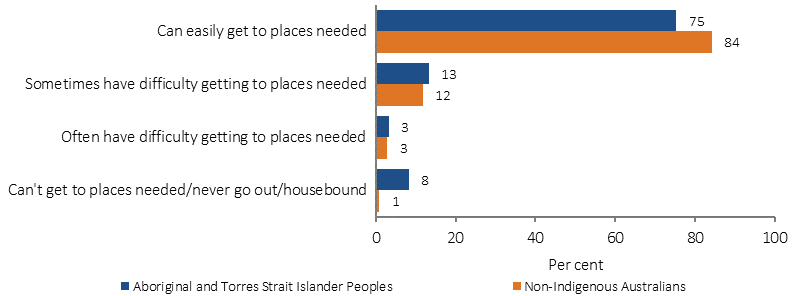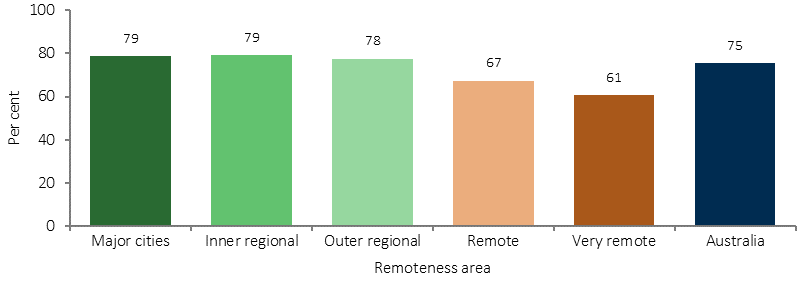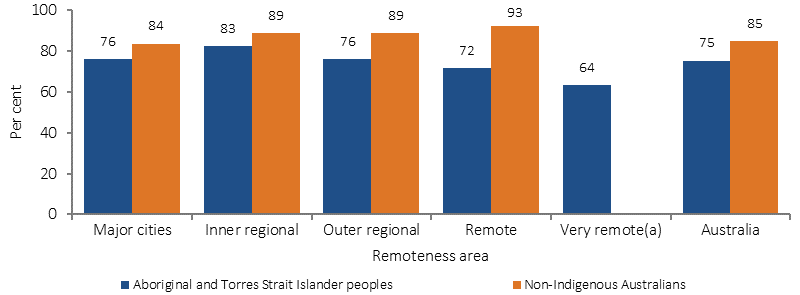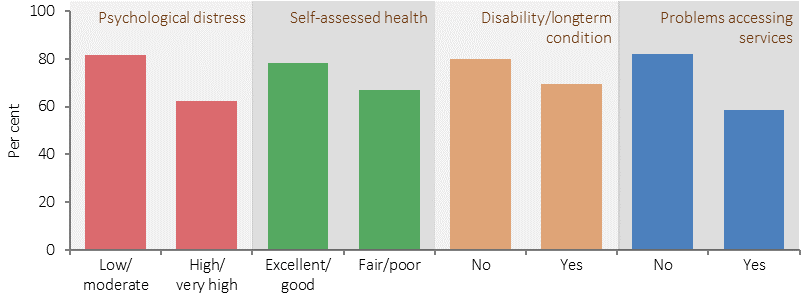2.13 Transport
Page content
Why is it important?
Transport is a key enabler for access to health care, goods and services, and supports Aboriginal and Torres Strait Islander peoples to achieve education and employment outcomes and maintain cultural obligations to travel to family commitments (Helps et al, 2010; Ivers et al, 2016).
Aboriginal and Torres Strait Islander peoples face various barriers to accessing appropriate health care (see measure 3.14) including logistics, cost and reliability of transport options. These challenges have a broader impact on the social and economic circumstances of both health service users who need to travel significant distances while unwell, and on carers who support attendance at services for antenatal care, young children, people with a disability, or people suffering from chronic health conditions, mental health or substance use issues (Lee et al, 2014). Limited or no public transport options significantly impact on the capacity to access specialist health care, particularly for patients with chronic health conditions (Teng et al, 2014) or requiring birthing services (Parker, S et al, 2014) in rural and remote areas (Kelly et al, 2014).
Findings
Transport/distance was a reason 16% of Indigenous Australians reported they did not access health services when they needed to in 2012–13 (Health Survey). For specific types of services, transport/distance was a reported barrier to visiting a hospital (17%), a doctor (14%), a dentist (11%), counsellors (10%), and other health professionals (13%).
Logistical reasons (transport/distance, waiting time too long, availability of service in the area) were a greater barrier to accessing a health provider when needed (40%) than cost (36%) or cultural appropriateness of services (32%). Logistical reasons were a greater barrier to accessing hospital services (37%) than cultural appropriateness of services (27%) or cost (8%). Likewise, logistical reasons were a greater barrier to accessing a doctor (34%) than cultural appropriateness of services (23%) or cost (13%). Logistical reasons were second only to cost as a barrier to accessing dental services and other health professionals.
In 2014–15, 75% of Indigenous Australians aged 15 years and over reported they can easily get to places needed; an increase from 70% in 2002. For non-Indigenous Australians, 84% reported being easily able to get to places needed. There was a clear gradient by remoteness with the proportion of Indigenous Australians able to easily get to places when needed decreasing from 79% in both major cities and inner regional areas down to 61% in very remote areas. Rates were highest in NSW (81%) and lowest in the NT (60%). Age also had an effect, with 70% of 15–24 year olds reporting they can easily get to places needed rising to 79% for those aged 45 years and over.
In 2014–15, 8% of Indigenous Australians reported being unable to get to places needed/never go out/housebound compared with 1% of non-Indigenous Australians.
In 2014–15, Indigenous Australians aged 15 years and over were less likely to have access to a motor vehicle than non-Indigenous Australians (75% compared with 85% respectively). The gap was widest in remote/very remote areas combined where 67% of Indigenous Australians had access to a vehicle compared with 92% of non-Indigenous Australians; in non-remote areas the gap was smaller (78% compared to 85%). Rates varied across jurisdictions, with those living in the ACT reporting the highest rates of access to a vehicle (84%) and those in the NT the lowest (66%).
In 2014–15, 29% of Indigenous Australians aged 15 years and over had used public transport in the previous two weeks. Of those who hadn’t used it, 51% lived in an area in which there was no public transport available. Use of public transport was lower in remote areas (13%) than in non-remote areas (34%). Research has found that 35% of Aboriginal and Torres Strait Islander people were subjected to racism while using public transport (Ferdinand et al. 2012). This, along with availability of public transport, impedes access to services.
In 2014–15, transport services were provided by 84% of Commonwealth-funded Indigenous primary health care services (AIHW, 2016o).
Unsurprisingly, Indigenous Australians aged 15 years and over who can easily get to places needed were less likely to report having problems accessing services. They were also less likely to have a disability/long term health condition, to report high/very high levels of psychological distress or to rate their health as fair/poor.
While transport is a key enabler of access to health services, it also poses risks to health if the mode of transport is unsafe, such as a vehicle not in good working order, or a driver operating a vehicle while under the influence of alcohol or drugs (Symons et al, 2012; Fitts et al, 2013). Hospitalisation and deaths due to injuries from transport accidents remain a concern (see measure 1.03).
Figures
Table 2.13-1
Indigenous Australians who did not access health services when needed to and reasons relating to logistics, 2012–13
| Dentist | Doctor | Other health professional | Hospital | Counsellor | |
|---|---|---|---|---|---|
| Per cent | |||||
| Did not access service when needed to in last 12 months | 21 | 14 | 9 | 6 | 9 |
| Reason(s) did not access service | |||||
| Waiting time too long or not available at time required | 20 | 22 | 17 | 25 | 12 |
| Transport/distance | 11 | 14 | 13 | 17 | 10 |
| Service not available in area | 9 | 5 | 6 | 3 | 6 |
| Logistical reasons (subtotal) | 33 | 34 | 28 | 37 | 22 |
Source: ABS and AIHW analysis of 2012–13 AATSIHS
Figure 2.13-1
Perceived level of difficulty with transport for persons aged 15 years over, by Indigenous status, 2014–15

Source: ABS and AIHW analysis of 2014–15 NATSISS
Figure 2.13-2
Proportion of Indigenous Australians aged 15 years and over who can get to places needed, by remoteness, 2014–15

Note: Includes people who never go out and are housebound
Source: ABS and AIHW analysis of 2014–15 NATSISS
Figure 2.13-3
Proportion of persons aged 15 years and over with access to a motor vehicle, by Indigenous status and remoteness, 2014–15

Source: ABS and AIHW analysis of 2014–15 NATSISS
Figure 2.13-4
Relationship between being easily able to get to places needed and selected health outcomes, Indigenous Australians 15 years and over, 2014–15

Source: ABS and AIHW analysis of 2014–15 NATSISS
Implications
While public transportation may compensate for the lack of private transport in non-remote areas, a higher proportion of Indigenous Australians in both remote and non-remote areas have less access to a motor vehicle compared with non-Indigenous Australians.
Indigenous Australians also experience barriers to obtaining a driver’s licence, including financial hardship; literacy and language issues; identity requirements; driving practise requiring access to a car, an experienced driver and being able to afford petrol; and cyclical fine defaults (Cullen et al, 2016). Schemes to assist patients with travel and associated accommodation operate in the various jurisdictions. Other approaches have also been adopted, such as support for specialist services flying into remote localities.
Patient transport services designed to assist patients with chronic illnesses to access health services on a regular basis are an important aspect of health service delivery. This is particularly the case for Indigenous households where private and public transport options are often restricted. Patient transport services are provided by a broad range of services including voluntary groups, Aboriginal Community Controlled Health Organisations (ACCHOs), hospitals and ambulance services.
For example, the WA Department of Health has funded patient transport officers and patient journey officers in ACCHOs and area health services to ensure that Aboriginal patients have adequate transport to medical appointments at all levels of the health system (primary, secondary and tertiary). Unfortunately, the provision of these services varies significantly across Australia and access is not always assured.
Queensland Health provides the Indigenous Cardiovascular Outreach Program and the Indigenous Respiratory Outreach Care Program to deliver a range of primary, secondary and tertiary health care services in locations with limited access to specialist services.